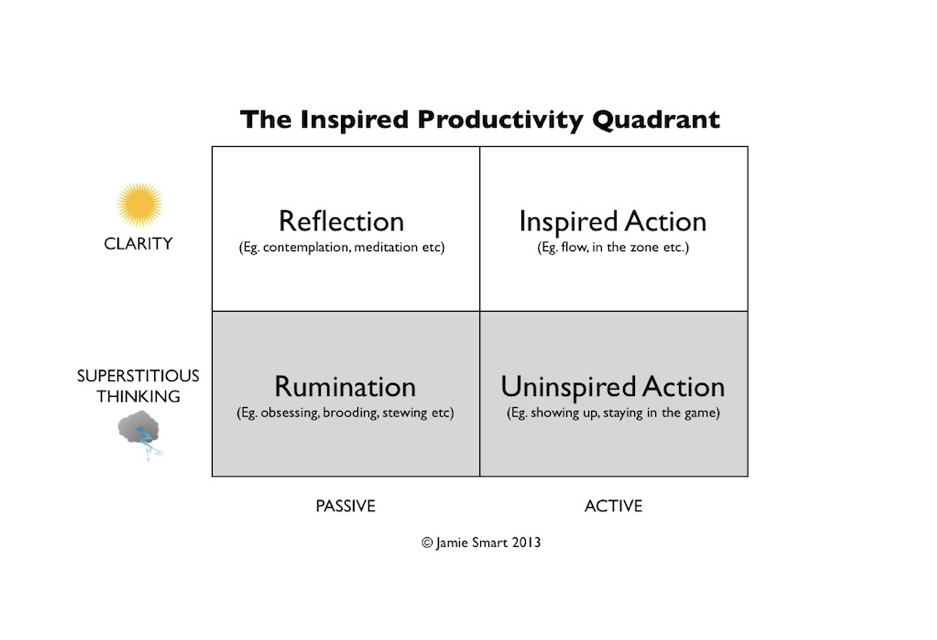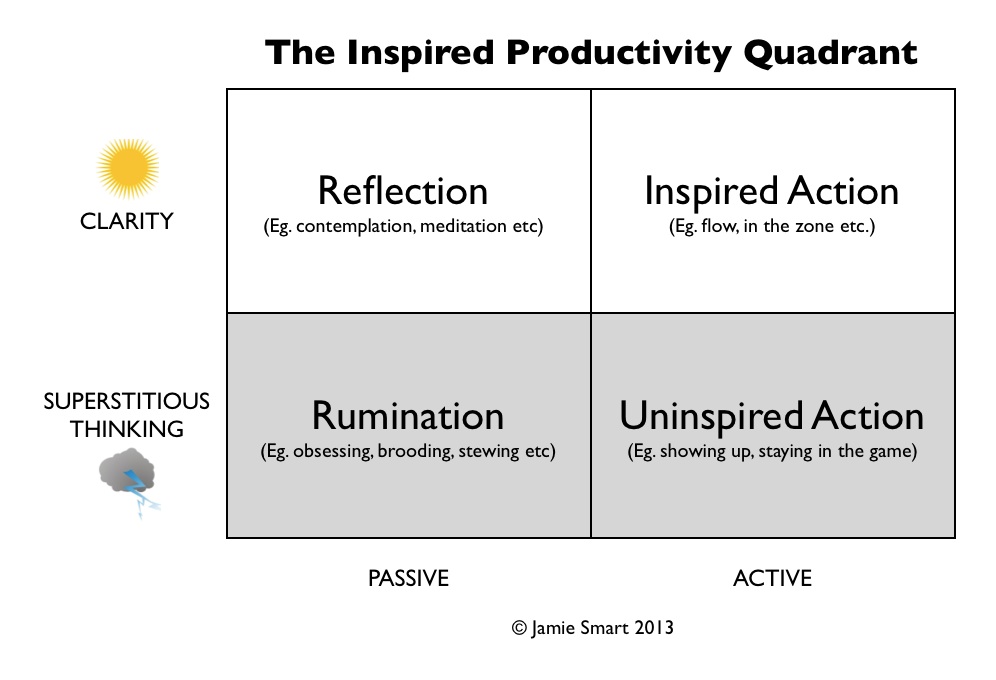JST 4 – The Inspired Productivity Quadrant
“Eighty percent of success is showing up”
– Woody Allen
Last week, I wrote an article called ‘The Myth of Inspiration’, in which I revealed one of the most limiting ideas that I see many people suffering from; the mistaken belief that they need to feel inspired before they take action. This misguided idea keeps people in the zone of passivity, waiting for metaphorical lightning to strike so they can start moving forward. In this week’s article, I’ll be revealing why and how passivity can actually be a source of power and inspiration, and how you can get it to work for you rather than against you…
The alternative to the inspiration myth (what I call ‘the perspiration reality’) involves taking action even when you’re not feeling inspired, secure in the knowledge that inspiration will show up when you need it. When you’re not feeling inspired, (as my dear friend, Stillpower author Garret Kramer says), “Stay in the game.”
But there are times when it pays to be ‘passive’. Many of the great discoveries through history have come as the result of an insight, fresh new thinking that shows up when the thinker is in a state of contemplation, reflection or meditation. So how does this reconcile with ‘the perspiration reality’? Many of my clients appreciate the following diagram, which I call The Inspired Productivity Quadrant.
The quadrant describes four zones, which I describe below:
1. The zone of Rumination (passive)
People oscillate between periods of clarity, and periods of getting caught up in their thinking. When we’re caught up in our thoughts, it’s almost always an example of what I call ‘superstitious thinking’, the mistaken belief that our feelings are coming from somewhere other than our thinking in the moment.
The zone of rumination is unhelpful and unproductive. Nevertheless, we all end up there from time to time. Here are some of the signals that let you know a person may be caught up in the zone of rumination:
– Using their habitual thought-patterns to try and think their way out of a problem
– Caught up in ‘analysis paralysis’ as they try and create a foolproof plan
– Worry and anxiety about a future or past situation
– Caught up in dissatisfaction and “I’ll be happy when…” thinking
– Feeling frustrated as they wait for inspiration to strike
We have seasons, just like the rest of nature. We’re not all 100% productive 100% of the time. Here are a couple of tips for when you find yourself in the zone of rumination. These aren’t ‘how tos’, but rather some perspectives you might like to consider if you should find yourself struggling:
– Give up on your habitual patterns of superstitious thinking. The feeling of stress / anxiety / frustration is often a reliable indicator that you’ve slipped into superstitious, outside-in thinking. Just recognising this fact can often help you loosen your grip on it.
– Look away from your thinking and towards what’s creating it; the principle of thought. We’re always living in the feeling of our thinking, and we’re connected to an infinite source of fresh new thinking. Looking to the universal nature of thought is often more fruitful than struggling with habitual thought patterns.
– Jump into uninspired action…
2. The zone of Uninspired Action (active)
The zone of uninspired action is the ‘perspiration reality’ I referred to earlier. Getting into action gives you something to be doing and focusing on. Your mind is a self-correcting system, so you’re going to get new thinking sooner or later. When you’re taking action, it’s surprising how often new thinking shows up. When a person’s in the zone of uninspired action, there’s sometimes a sense of strain, struggle and ‘slogging away at it’. That’s OK. Stay in the game. A couple of tips for navigating the zone of uninspired action:
– If you’re particularly caught up in your thinking, do your best to avoid making any important decisions / having those really important conversations.
– Pay attention to the subtle (or not so subtle) signals of your wisdom / intuition. Stop and rest when it occurs to you to do so. If it strikes you that having a break (eg. going for a walk, relaxing etc) would be a good idea, go with it.
– You may even find yourself pausing and easing into the zone of reflection…
3. The zone of Reflection (passive)
The zone of reflection is a powerful source of fresh new thinking, a zone of renewal and regeneration. Newton’s theory of universal gravitation, Archimedes’ eureka moment and Steve Jobs’ insights about the future of the music business all came in moments of reflection, when they weren’t actively ‘thinking’ about the matter at hand. There are countless ways of entering a state of reflection and contemplation. I’ve had numerous examples from clients over the years (including walking, sitting by the ocean, riding, meditating, reading, listening to certain music, sitting in the bath etc.)
As you continue exploring the inside-out nature of life, and the principles behind clarity, you’ll find yourself being guided into the zone of reflection more easily and spontaneously. (For more on the zone of reflection, check out 'The 5 Reasons Why You Don't Need to Meditate'). And from time to time, you’ll get struck with inspiration, an insight that shows you the way forward. When that happens, it’s time for inspired action…
4. The zone of Inspired Action (active)
The zone of inspired action is where you can’t seem to put a foot wrong, where everything’s falling into place and you feel guided and directed. Enjoy it when it comes, and stay in the game when it’s nowhere to be found. As you continue deepening your understanding of the principles behind clarity, you’ll find yourself in the zone of inspired action more often. And when you’re not there, you’ll know that it’s never far away.
To your increasing clarity,
Jamie

